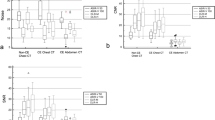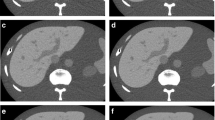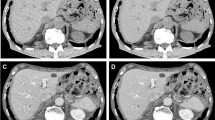Abstract
Objective
To evaluate the effect of a commercial deep learning algorithm on the image quality of chest CT, focusing on the upper abdomen.
Methods
One hundred consecutive patients who simultaneously underwent contrast-enhanced chest and abdominal CT were collected. The radiation dose was optimized for each scan (mean CTDIvol: chest CT, 3.19 ± 1.53 mGy; abdominal CT, 7.10 ± 1.88 mGy). Three image sets were collected: chest CT reconstructed with an adaptive statistical iterative reconstruction (ASiR-CHT; 50% blending), chest CT with a deep learning algorithm (DLIR-CHT), and abdominal CT with ASiR (ASiR-ABD; 40% blending). Afterwards, the images covering the upper abdomen were extracted, and image noise, the signal-to-noise ratio (SNR), and the contrast-to-noise ratio (CNR) were measured. For subjective evaluation, three radiologists independently assessed noise, spatial resolution, presence of artifacts, and overall image quality. Additionally, readers selected the most preferable reconstruction technique among three image sets for each case.
Results
The average measured noise for DLIR-CHT, ASiR-CHT, and ASiR-ABD was 8.01 ± 2.81, 14.8 ± 2.56, and 12.3 ± 2.28, respectively (p < .001). Deep learning–based image reconstruction (DLIR) also showed the best SNR and CNR (p < .001). However, in the subjective analysis, ASiR-ABD showed less subjective noise than DLIR (2.94 ± 0.23 vs. 2.87 ± 0.26; p < .001), while DLIR showed better spatial resolution (2.60 ± 0.34 vs. 2.44 ± 0.31; p = .02). ASiR-ABD showed a better overall image quality (p = .001), but two of the three readers preferred DLIR more frequently.
Conclusion
With < 50% of the radiation dose, DLIR chest CT showed comparable image quality in the upper abdomen to that of dedicated abdominal CT and was preferred by most readers.
Key Points
• With < 50% radiation dose, a deep learning algorithm applied to contrast-enhanced chest CT exhibited better image noise and signal-to-noise ratio than standard abdominal CT with the ASiR technique.
• Pooled readers mostly preferred deep learning algorithm–reconstructed contrast-enhanced chest CT reconstructed using a standard ASiR-reconstructed abdominal CT.
• Reconstruction algorithm–induced distortion artifacts were more frequently observed on deep learning algorithm–reconstructed images, but diagnostic difficulty was reported in only 0.3% of cases.





Similar content being viewed by others
Abbreviations
- ABD:
-
Abdominal CT
- ASiR:
-
Adaptive statistical iterative reconstruction
- CHT:
-
Chest CT
- CNR:
-
Contrast-to-noise ratio
- CTDI:
-
Computed tomographic dose index
- DLIR:
-
Deep learning–based image reconstruction
- FBP:
-
Filtered back projection
- ROI:
-
Region of interest
- SNR:
-
Signal-to-noise ratio
References
Mettler FA Jr, Mahesh M, Bhargavan-Chatfield M et al (2020) Patient exposure from radiologic and nuclear medicine procedures in the United States: procedure volume and effective dose for the period 2006–2016. Radiology 295:418–427
Deak PD, Smal Y, Kalender WA (2010) Multisection CT protocols: sex-and age-specific conversion factors used to determine effective dose from dose-length product. Radiology 257:158–166
Prakash P, Kalra MK, Kambadakone AK et al (2010) Reducing abdominal CT radiation dose with adaptive statistical iterative reconstruction technique. Invest Radiol 45:202–210
Singh S, Kalra MK, Shenoy-Bhangle AS et al (2012) Radiation dose reduction with hybrid iterative reconstruction for pediatric CT. Radiology 263:537–546
Sagara Y, Hara AK, Pavlicek W, Silva AC, Paden RG, Wu Q (2010) Abdominal CT: comparison of low-dose CT with adaptive statistical iterative reconstruction and routine-dose CT with filtered back projection in 53 patients. AJR Am J Roentgenol 195:713–719
Park C, Choo KS, Jung Y, Jeong HS, Hwang J-Y, Yun MS (2020) CT iterative vs deep learning reconstruction: comparison of noise and sharpness. Eur Radiol ahead of print. https://doi.org/10.1007/s00330-020-07535-9
Greffier J, Hamard A, Pereira F et al (2020) Image quality and dose reduction opportunity of deep learning image reconstruction algorithm for CT: a phantom study. Eur Radiol 30:3951–3959
Hsieh J, Liu E, Nett B, Tang J, Thibault J-B, Sahney S (2019) A new era of image reconstruction: TrueFidelity™. White Paper (JB68676XX), GE Healthcare
Vardhanabhuti V, Loader RJ, Mitchell GR, Riordan RD, Roobottom CA (2013) Image quality assessment of standard-and low-dose chest CT using filtered back projection, adaptive statistical iterative reconstruction, and novel model-based iterative reconstruction algorithms. AJR Am J Roentgenol 200:545–552
Hu X, Ding X, Wu R, Zhang M (2011) Radiation dose of non-enhanced chest CT can be reduced 40% by using iterative reconstruction in image space. Clin Radiol 66:1023–1029
Marin D, Nelson RC, Schindera ST et al (2010) Low-tube-voltage, high-tube-current multidetector abdominal CT: improved image quality and decreased radiation dose with adaptive statistical iterative reconstruction algorithm—initial clinical experience. Radiology 254:145–153
Nakayama Y, Awai K, Funama Y et al (2005) Abdominal CT with low tube voltage: preliminary observations about radiation dose, contrast enhancement, image quality, and noise. Radiology 237:945–951
Hur S, Lee JM, Kim SJ, Park JH, Han JK, Choi BI (2012) 80-kVp CT using iterative reconstruction in image space algorithm for the detection of hypervascular hepatocellular carcinoma: phantom and initial clinical experience. Korean J Radiol 13:152–164
Wong K, Paulson EK, Nelson RC (2001) Breath-hold three-dimensional CT of the liver with multi-detector row helical CT. Radiology 219:75–79
McClellan TR, Motosugi U, Middleton MS et al (2017) Intravenous gadoxetate disodium administration reduces breath-holding capacity in the hepatic arterial phase: a multi-center randomized placebo-controlled trial. Radiology 282:361–368
Stengel D, Ottersbach C, Matthes G et al (2012) Accuracy of single-pass whole-body computed tomography for detection of injuries in patients with major blunt trauma. CMAJ 184:869–876
Leung V, Sastry A, Woo T, Jones H (2015) Implementation of a split-bolus single-pass CT protocol at a UK major trauma centre to reduce excess radiation dose in trauma pan-CT. Clin Radiol 70:1110–1115
Ptak T, Rhea JT, Novelline RA (2003) Radiation dose is reduced with a single-pass whole-body multi-detector row CT trauma protocol compared with a conventional segmented method: initial experience. Radiology 229:902–905
Sedlic A, Chingkoe CM, Tso DK, Galea-Soler S, Nicolaou S (2013) Rapid imaging protocol in trauma: a whole-body dual-source CT scan. Emerg Radiol 20:401–408
Long B, April MD, Summers S, Koyfman A (2017) Whole body CT versus selective radiological imaging strategy in trauma: an evidence-based clinical review. Am J Emerg Med 35:1356–1362
Jeavons C, Hacking C, Beenen LF et al (2018) A review of split-bolus single-pass CT in the assessment of trauma patients. Emerg Radiol 25:367–374
Scialpi M, Schiavone R, D'Andrea A et al (2015) Single-phase whole-body 64-MDCT split-bolus protocol for pediatric oncology: diagnostic efficacy and dose radiation. Anticancer Res 35:3041–3048
Israel GM, Herlihy S, Rubinowitz AN, Cornfeld D, Brink J (2008) Does a combination of dose modulation with fast gantry rotation time limit CT image quality? AJR Am J Roentgenol 191:140–144
Funding
This work was supported by a grant of the Korea Health Technology R&D Project through the Korea Health Industry Development Institute (KHIDI), funded by the Ministry of Health & Welfare, Republic of Korea (grant number: HI19C1129).
Author information
Authors and Affiliations
Corresponding author
Ethics declarations
Guarantor
The scientific guarantor of this publication is Jin Mo Goo.
Conflict of interest
No authors have relationships with any companies whose products or services may be related to the subject matter of the article.
Statistics and biometry
No complex statistical methods were necessary for this paper.
Informed consent
Written informed consent was waived by the institutional review board.
Ethical approval
Institutional review board approval was obtained.
Methodology
• retrospective
• observational
• performed at one institution
Additional information
Publisher’s note
Springer Nature remains neutral with regard to jurisdictional claims in published maps and institutional affiliations.
Rights and permissions
About this article
Cite this article
Nam, J.G., Hong, J.H., Kim, D.S. et al. Deep learning reconstruction for contrast-enhanced CT of the upper abdomen: similar image quality with lower radiation dose in direct comparison with iterative reconstruction. Eur Radiol 31, 5533–5543 (2021). https://doi.org/10.1007/s00330-021-07712-4
Received:
Revised:
Accepted:
Published:
Issue Date:
DOI: https://doi.org/10.1007/s00330-021-07712-4




